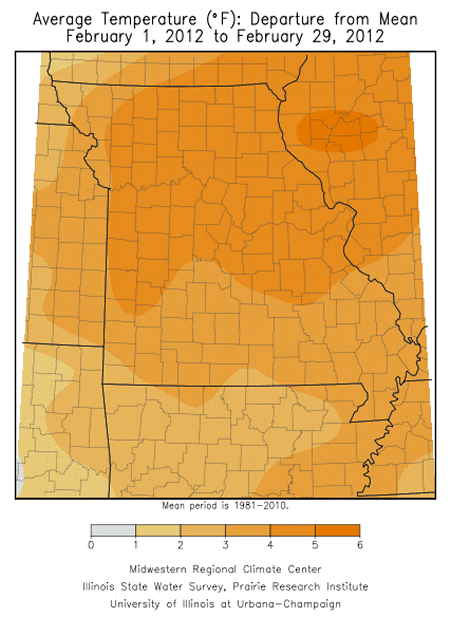
February 2012 Weather and
Its Impacts on Missouri
Pat Guinan
State Climatologist
Commercial Agriculture/University of Missouri Extension
Unseasonably warm temperatures persisted for much of February on what ended up being one of the mildest winters in decades for the Show Me state. Preliminary numbers indicate an average statewide temperature of 39°F for February, nearly 5 degrees above normal. Regionally, temperatures averaged between 34-37°F over northern sections, 38-41°F across central Missouri and 40-43°F in the southern third of the state. The Missouri Bootheel experienced the mildest weather, averaging between 44-46°F. Most days averaged above normal during the month with only 5-7 days recording below normal temperatures. Seasonally, about 70% of the days, from December through February, averaged above normal, and will rank the winter of 2011-12 in the "Top 5" mildest winters for Missouri, and the warmest since the winter of 1991-92.
Precipitation was variable across the state in February and ranged from above normal in northwestern and west central Missouri to near to below normal elsewhere. Generally, 2-3 inches were common for most locations, but there were drier areas, especially in northeastern sections, where 1-1.5 inches were common. Other dry pockets were found in far southwestern Missouri and some southeastern counties where 1-2 inches were reported. Some of the highest precipitation totals came from observers in Nodaway, Platte and Clay counties where 3.57, 3.51, and 3.46 inches were reported, respectively. Lowest precipitation totals were reported in Barry, Ralls, Knox, and New Madrid counties where 1.07, 1.10, 1.12, and 1.28 inches were observed, respectively. Preliminary numbers indicated a statewide average of 2.3 inches, slightly above the statewide norm.
The mild temperature regime provided few opportunities for any snow or ice events to impact the state. The most significant winter event occurred on February 13-14 when a storm system dropped 1-4 inches of snow across a large part of the state.
A highly unusual multi-state tornado outbreak occurred at the end of the month, when a strong storm system swept through the Midwest, and dropped tornadoes from Nebraska to Tennessee. Preliminary surveys indicate 36 tornadoes touched down and resulted in 13 fatalities - 6 in Illinois, 3 in Missouri, 3 in Tennessee and 1 in Kansas.
Twelve tornadoes ravaged portions of southern Missouri just before midnight on the 28th and continued into the early morning hours of Leap Day. Barry, Dallas, and Stoddard counties in Missouri each reported one tornado related fatality. All three fatalities occurred in mobile homes and were associated with EF-2 tornadoes (120 mph) impacting Barry county and Dallas county, and one EF-3 tornado (140 mph) in Stoddard county.
Additionally, the community of Branson was struck by an EF-2 tornado, just after midnight on Leap Day. It tore through the heart of the tourist district, more widely known as the Branson Strip. Six of the more than 50 theaters sustained significant damage and 22 hotels experienced various levels of damage. The impacts could have been much worse if the tornado struck two weeks later, when tourists arrive in full force with the start of spring break.
The mild February weather allowed for spring growth and development in floral gardens and natural vegetation and has created concern for injury that may result due to the likelihood of sub-freezing temperatures during March. The average date for the last moderate freeze (24-28°F) ranges from March 16 in southeastern Missouri to April 10 in the northern border counties.
















